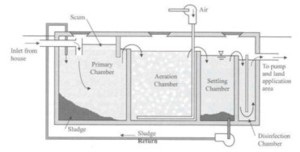Aerated Wastewater Treatment Systems (AWTS) - How They Work

Cross Section of AWTS
Four processes occur in an Aerated Wastewater Treatment System (AWTS). Each of the processes takes place in a separate compartment in the tank.
- The settling of solids and floating of scum in the primary chamber.
- The consumption of organic matter in the aeration chamber by biological activity. The oxygen required for this process is provided by the blower. This is typically the box like structure on top of the AWTS. This should emit a low humming noise if working. If the humming noise is not heard for several hours, then immediately call the service technician as your system has failed.
- The further settling of solids in a clarification chamber.
- Disinfection in the chlorination chamber and pumped out to irrigation.
An AWTS must be operated continuously and power to the system must NOT be turned off. If it is a holiday home that is unoccupied for long periods at a time, the system will need to be serviced by a technician at each start up.
An AWTS is a miniature sewage treatment plant and requires regular maintenance. As a result of field trials from NSW Health, it was determined that the systems need to be serviced at a minimum every three months. Therefore the owner/resident of the premises must:
- Enter into an annual service contract with a service technician. This contract stipulates that the service technician will provide an annual service contract of four services at three monthly intervals.
The service agent must be able to provide service within 24 hours of being notified of a system malfunction. Each service should consist of:
- Replenishment of chlorine tablets
- Check all pumps
- Check the air blower
- Check the alarm
- Check effluent irrigation pipes/sprays
- Measure sludge levels
- Chlorine reading and pH.
The service typically should last 20-25 minutes if there are no problems with the system.